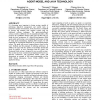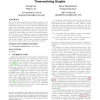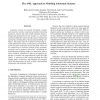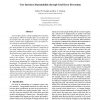446 search results - page 62 / 90 » Design Principles for Tactile Interaction |
CATA
2003
13 years 9 months ago
2003
It is becoming more important to design systems capable of performing high-level management and control tasks in interactive dynamic environments. At the same time, it is difficul...
KDD
2007
ACM
14 years 8 months ago
2007
ACM
How can we find communities in dynamic networks of social interactions, such as who calls whom, who emails whom, or who sells to whom? How can we spot discontinuity timepoints in ...
ICAS
2006
IEEE
14 years 1 months ago
2006
IEEE
Autonomic systems are typically distributed, complex and concurrent systems, comprised of multiple interacting autonomic elements that often exhibit emergent behavior. Design and ...
DSN
2005
IEEE
14 years 1 months ago
2005
IEEE
User interfaces form a critical coupling between humans and computers. When the interface fails, the user fails, and the mission is lost. For example, in computer security applica...
AAMAS
2000
Springer
13 years 7 months ago
2000
Springer
We adopt the decision-theoretic principle of expected utility maximization as a paradigm for designing autonomous rational agents, and present a framework that uses this paradigm t...




